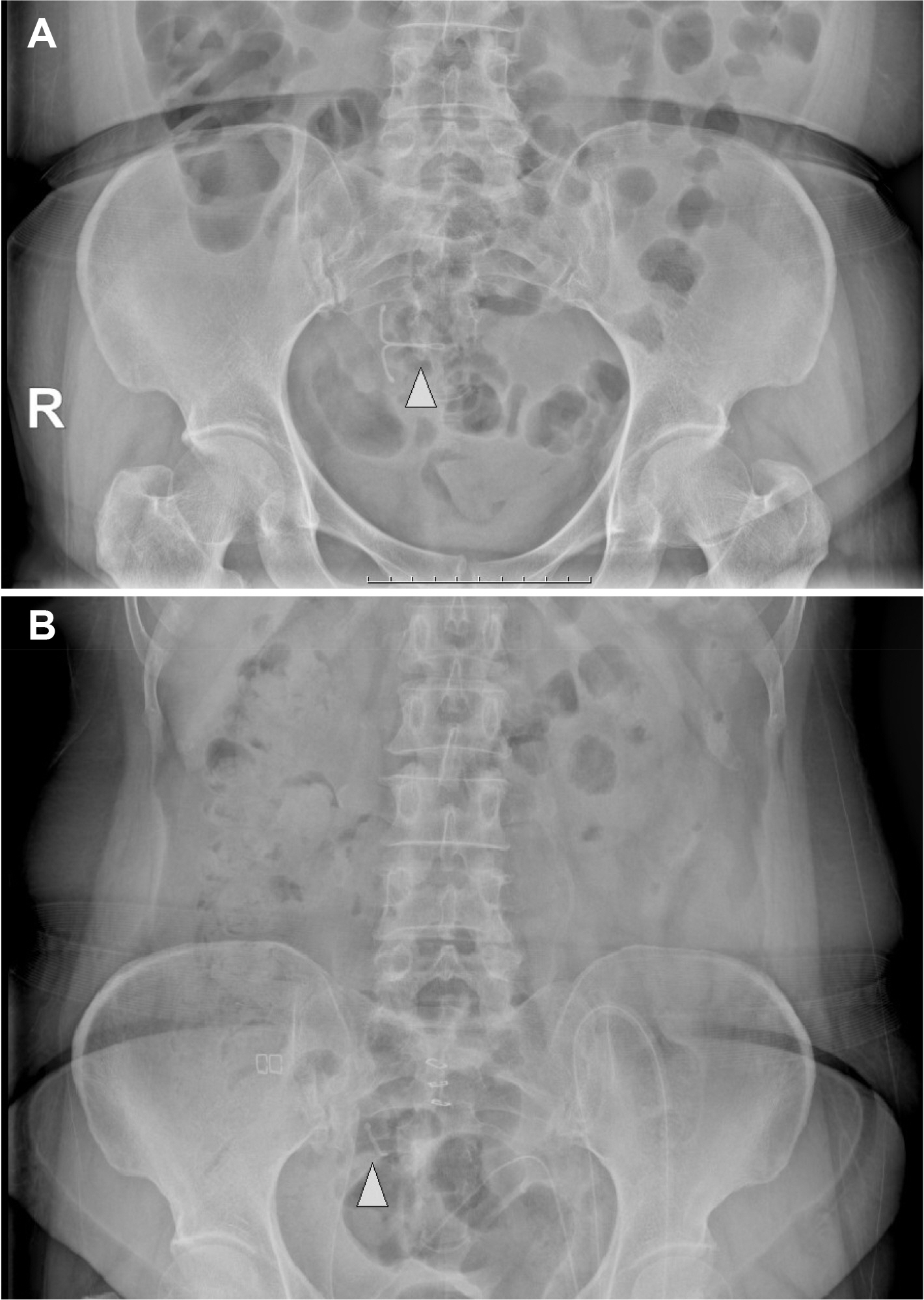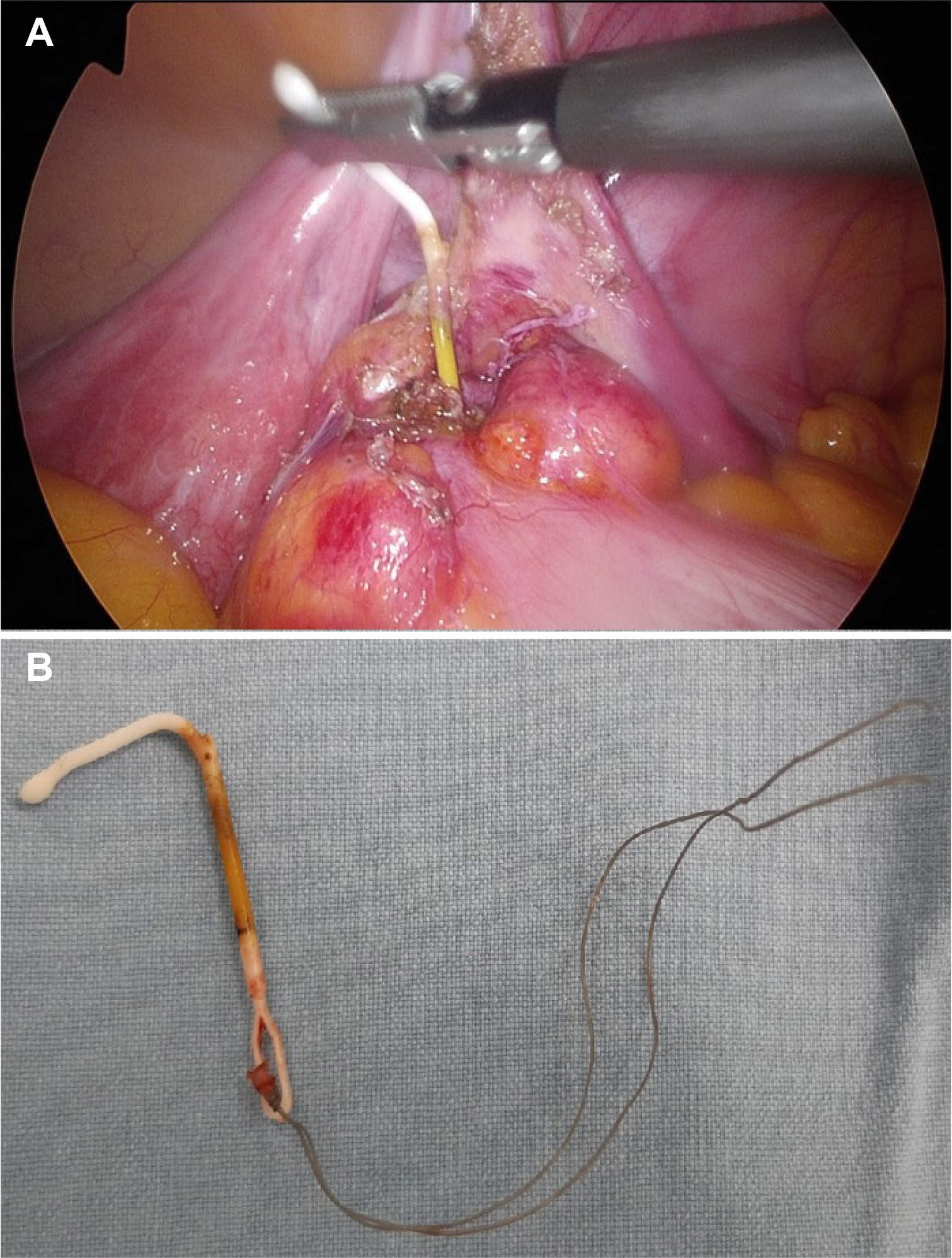Korean J Gastroenterol.
2021 Jul;78(1):48-52. 10.4166/kjg.2021.041.
Incomplete Removal of an Intrauterine Device Perforating the Sigmoid Colon
- Affiliations
-
- 1Division of Gastroenterology, Department of Internal Medicine, College of Medicine, The Catholic University of Korea, Seoul, Korea
- KMID: 2518752
- DOI: http://doi.org/10.4166/kjg.2021.041
Abstract
- Intrauterine devices (IUDs) are widely used for contraception in South Korea. However, several complications of IUDs have been reported, including inflammation, obstruction, perforation, and fistula. IUD perforation is the rarest of these complications but is also severe. Migrated IUDs can be retrieved through endoscopy, laparoscopy, or laparotomy. Presented below is an atypical case of an IUD perforating the sigmoid colon, which could not be removed endoscopically, and was subsequently incompletely removed through laparoscopic surgery. The present case underlines the importance of appropriate diagnosis and treatment approach in the management of IUD perforation.
Keyword
Figure
Reference
-
1. Park JM, Lee CS, Kim MS, et al. 2010; Penetration of the descending colon by a migrating intrauterine contraceptive device. J Korean Soc Coloproctol. 26:433–436. DOI: 10.3393/jksc.2010.26.6.433. PMID: 21221246. PMCID: PMC3017981.
Article2. Akpinar F, Ozgur EN, Yilmaz S, Ustaoglu O. 2014; Sigmoid colon migration of an intrauterine device. Case Rep Obstet Gynecol. 2014:207659. DOI: 10.1155/2014/207659. PMID: 25136463. PMCID: PMC4129669.
Article3. Takahashi H, Puttler KM, Hong C, Ayzengart AL. 2014; Sigmoid colon penetration by an intrauterine device: a case report and literature review. Mil Med. 179:e127–e129. DOI: 10.7205/MILMED-D-13-00268. PMID: 24402999.
Article4. Rahnemai-Azar AA, Apfel T, Naghshizadian R, Cosgrove JM, Farkas DT. 2014; Laparoscopic removal of migrated intrauterine device embedded in intestine. JSLS. 18:e2014.00122. DOI: 10.4293/JSLS.2014.00122. PMID: 25419105. PMCID: PMC4236077.
Article5. ACOG Practice Bulletin No. 121: Long-acting reversible contraception: implants and intrauterine devices. Obstet Gynecol. 118:184–196. DOI: 10.1097/AOG.0b013e318227f05e. PMID: 21691183.6. Jones J, Mosher W, Daniels K. 2012; Current contraceptive use in the United States, 2006-2010, and changes in patterns of use since 1995. Natl Health Stat Report. (60):1–25.7. Huh JM, Kim KS, Cho YS, et al. 2018; Colonoscopic removal of an intrauterine device that had perforated the rectosigmoid colon. Ann Coloproctol. 34:106–108. DOI: 10.3393/ac.2017.10.30. PMID: 29742863. PMCID: PMC5951096.
Article8. Barwin BN, Tuttle S, Jolly EE. 1978; The intrauterine contraceptive device. Can Med Assoc J. 118:53–58. DOI: 10.1097/00006254-197808000-00015. PMID: 620385. PMCID: PMC1880477.
Article9. Zakin D, Stern WZ, Rosenblatt R. 1981; Complete and partial uterine perforation and embedding following insertion of intrauterine devices. I. Classification, complications, mechanism, incidence, and missing string. Obstet Gynecol Surv. 36:335–353. DOI: 10.1097/00006254-198107000-00001. PMID: 7029368.10. Ozgun MT, Batukan C, Serin IS, Ozcelik B, Basbug M, Dolanbay M. 2007; Surgical management of intra-abdominal mislocated intrauterine devices. Contraception. 75:96–100. DOI: 10.1016/j.contraception.2006.09.011. PMID: 17241837.
Article11. Harrison-Woolrych M, Ashton J, Coulter D. 2003; Uterine perforation on intrauterine device insertion: is the incidence higher than previously reported? Contraception. 67:53–56. DOI: 10.1016/S0010-7824(02)00417-1.
Article12. Sun CC, Chang CC, Yu MH. 2008; Far-migrated intra-abdominal intrauterine device with abdominal pain. Taiwan J Obstet Gynecol. 47:244–246. DOI: 10.1016/S1028-4559(08)60095-9.
Article13. Gonenc M, Kalayci MU, Turhan AN, Deniztas C, Alis H. 2011; Endoscopic treatment of a transmigrated intrauterine device to colonic wall: a case report. Am J Obstet Gynecol. 204:e3–e5. DOI: 10.1016/j.ajog.2010.11.037. PMID: 21276950.
Article14. Gill RS, Mok D, Hudson M, Shi X, Birch DW, Karmali S. 2012; Laparoscopic removal of an intra-abdominal intrauterine device: case and systematic review. Contraception. 85:15–18. DOI: 10.1016/j.contraception.2011.04.015. PMID: 22067801.
Article15. Demir SC, Cetin MT, Ucünsak IF, Atay Y, Toksöz L, Kadayifçi O. 2002; Removal of intra-abdominal intrauterine device by laparoscopy. Eur J Contracept Reprod Health Care. 7:20–23. DOI: 10.1080/ejc.7.1.20.23. PMID: 12041860.
Article
- Full Text Links
- Actions
-
Cited
- CITED
-
- Close
- Share
- Similar articles
-
- Colonoscopic Removal of an Intrauterine Device That Had Perforated the Rectosigmoid Colon
- A Case of Hysteroscopic Removal of Intrauterine Device with Missing Tail during Early Pregnancy: Successful Ongoing Pregnancy
- Primary Ovarian Pregnancy with Intrauterine Device
- Extensive colonic stricture due to pelvic actinomycosis
- A Case of successful delivery after hysteroscopic removal of intrauterine device with missing tail during early pregnancy





